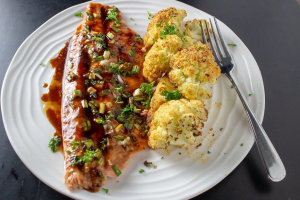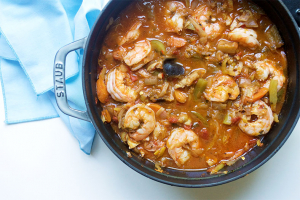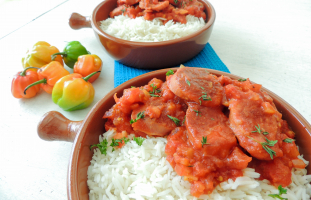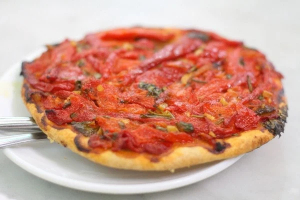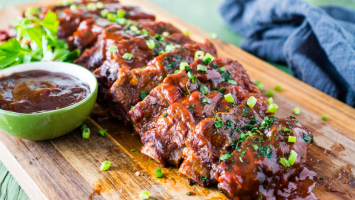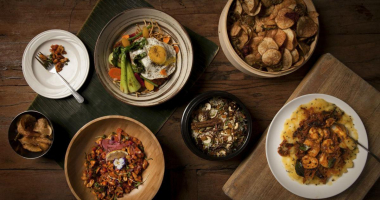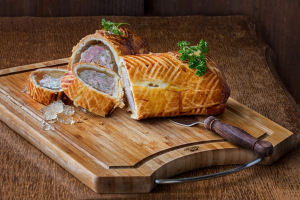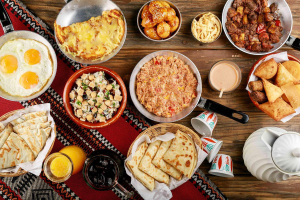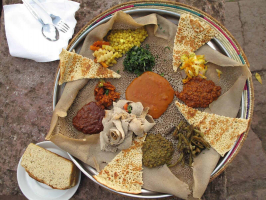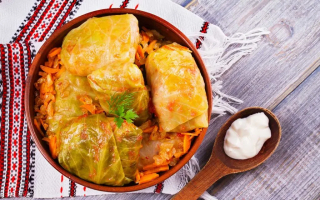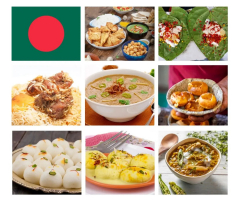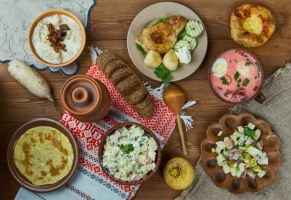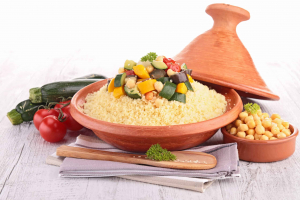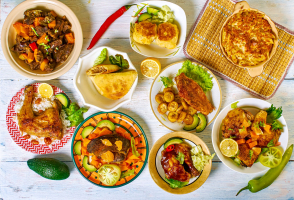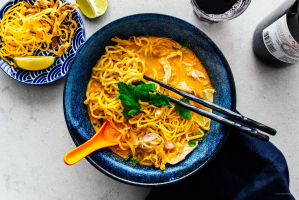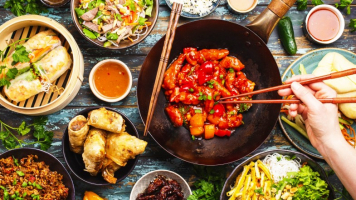Top 10 Best Foods In China With Recipe
Chinese food is an essential component of Chinese culture, with a lengthy history, distinct characteristics, a variety of styles, and beautiful cookery. The ... read more...color, perfume, taste, symbolism, and look of Chinese traditional foods are well-known. Because China is such a large nation, regional cuisines range greatly owing to variances in climate, history, local foods, eating habits, and so on. Chinese cuisines are split into eight categories based on cooking styles and regional flavors: Sichuan cuisine, Hunan cuisine, Shandong food, Zhejiang cuisine, Fujian cuisine, Anhui cuisine, Cantonese cuisine, and Jiangsu cuisine. Every cuisine has its own set of popular dishes. Toplist has put up a list of the best food in China that you must try.
-
Dumplings are a large category of foods made up of bits of dough (produced from a range of starch sources) wrapped around a filling or just dough. The dough can be made from bread, flour, buckwheat, or potatoes and stuffed with meat, fish, tofu, cheese, vegetables, fruits, or desserts. Dumplings are featured in many international cuisines and can be made in a variety of ways, including baking, boiling, frying, simmering, or steaming.
Ingredients
- 1.6-1.8kg duck , fresh or thawed thoroughly if frozen
- juice of 1 lemon
- 3 tbsp clear honey
- 3 tbsp dark soy sauce
- 150ml Shaohsing rice wine or dry Sherry
Instructions
- Wash your vegetables properly before blanching them in hot water. To cool, place them in an ice bath. Remove all of the water from the vegetables and finely chop them.
- Combine the vegetable, meat, wine, oil, sesame oil, salt, soy sauce, white pepper, and 2/3 cup water in a large mixing bowl. Mix for 6-8 minutes, or until everything is thoroughly incorporated.
- Dampen the edges of each circle with water before wrapping the dumplings. Fill the center with a little less than a tablespoon of filling. Fold the round in half and squeeze the top of the wrapping together. Make two folds on each side of the dumpling until it resembles a fan. Check to see if it's completely sealed. Rep with the remaining filling, placing the dumplings on a parchment-lined baking sheet. Check to see if the dumplings are stuck together.
- Wrap the baking sheets tightly with plastic wrap and place the pans in the freezer if you want to freeze them. Allow them to freeze for at least one night. The sheets can then be removed from the freezer, the dumplings transferred to Ziploc bags, and the bags returned to the freezer for later use.
- Boil or pan-fry the dumplings to prepare them. To boil the dumplings, simply bring a large pot of water to a boil, drop them in, and simmer until the skins are cooked through but still somewhat al dente.
- Heat 2 tablespoons oil in a nonstick pan over medium-high heat to pan-fry. Allow the dumplings to cook for 2 minutes in the pan. Cover the pan with a thin layer of water and reduce the heat to medium-low. Steam the dumplings until the water has disappeared. Remove the cover, increase the heat to medium-high, and continue to fry until the bottoms of the dumplings are golden brown and crisp.
- Serve with soy sauce, Chinese black vinegar, chili sauce, or your favorite dipping sauce!
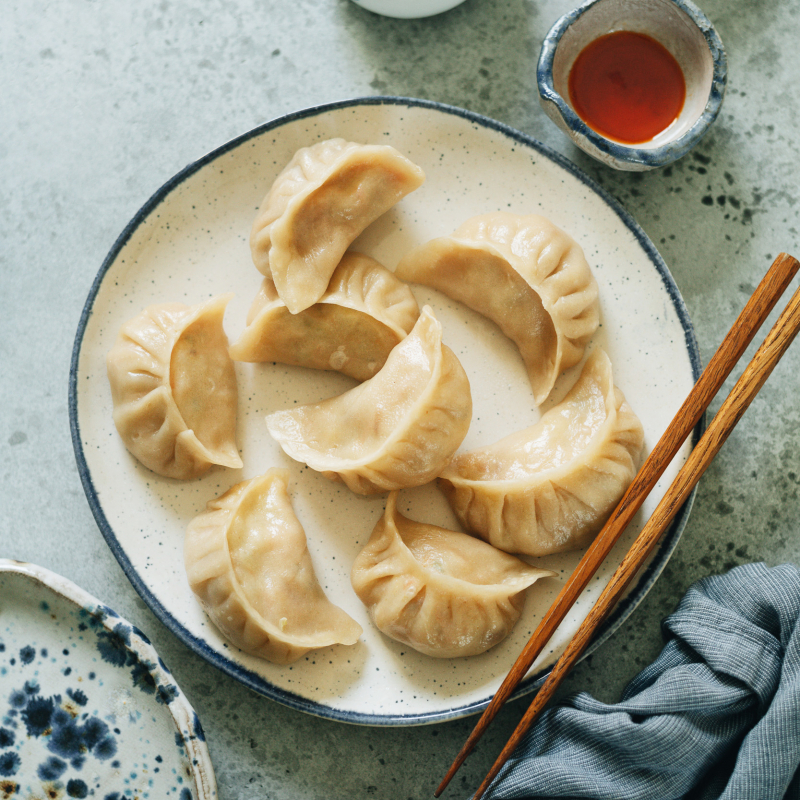
Photo: thekitchn.com 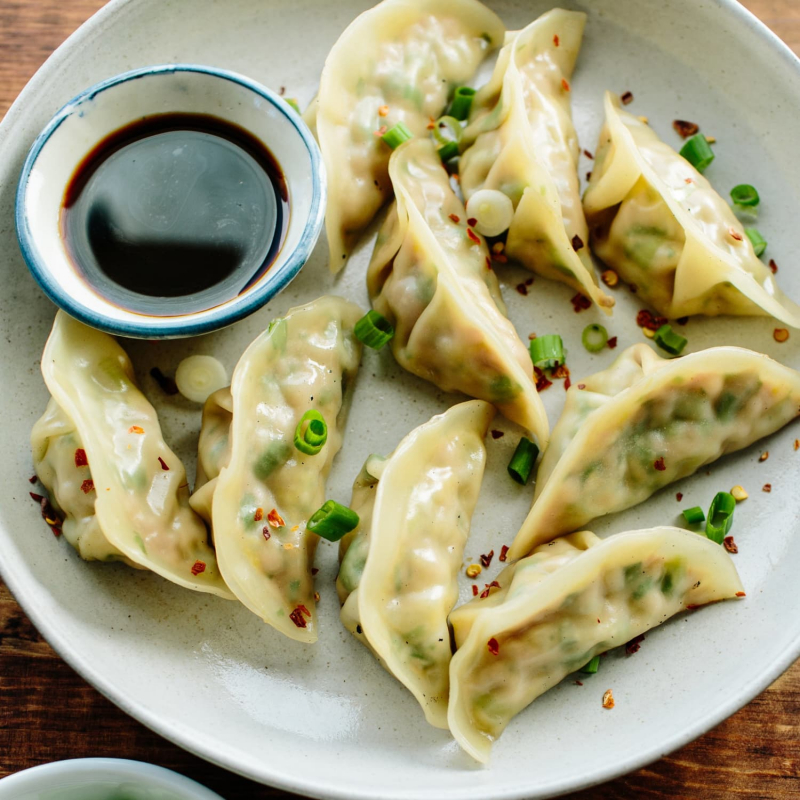
Photo: thekitchn.com -
Dim sum is a popular Cantonese cuisine dish. It includes a wide variety of small dishes such as dumplings, rolls, cakes, and meat, seafood, dessert, and vegetable preparations. Today, there are over a thousand different dim sum dishes.
Guangzhou is the birthplace of dim sum. Guangdong residents enjoy drinking tea in the morning or at lunch. As a result, they frequently eat dim sum for breakfast and lunch at their tea parties. It is a popular way to meet up with friends and family or to hold social gatherings. Find out more about Dim sum.
Ingredients
- 300 grams ground pork collar steak cut is always a good one
- 300 grams ground prawns Tiger prawns
- 5 tbsp soy sauce My recommendation Kikkoman Soy Sauce
- 2 tsp oyster sauce
- 2 tsp sesame oil
- 2 tsp sugar Brown sugar gives an intensive Flavor
- 1 tsp salt sea salt or table salt
- 20 pieces wonton skins Choose a package that has a darker color
- 2 chili pepers
- 1 minced onion
Instructions
- In a food processor, grind the prawns, then add the ground pork and the remaining ingredients and thoroughly combine.
- Place the wonton skins between your thumb and forefinger, add the filing in the center, and carefully push up the rest of the skin and push the filling with a teaspoon. Flatten the base so that the dim sum sits straight on the steamer.
- Fill a pan halfway with water and place your bamboo steamer on top, along with a basket containing a leaf of Chinese cabbage or baking paper with holes to hold your dim sums.
- Place the dim sum in the bamboo steamer basket, cover, and steam for approximately 12 minutes.
- Served with soy sauce.
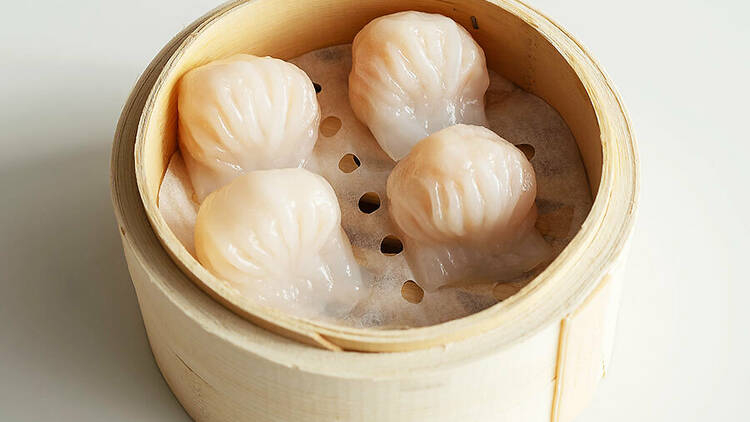
Photo: timeout.com 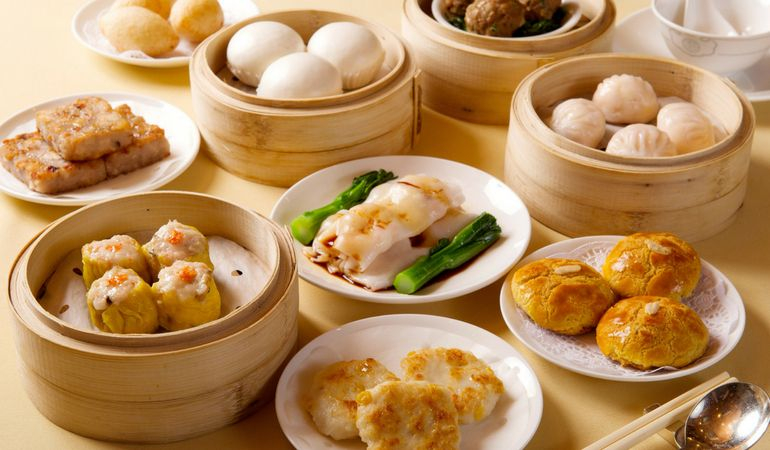
Photo: vnexpress.net -
Char siu means "fork roasted" in Cantonese, where char means "fork" and siu means "to roast." It's a Cantonese roast pork dish. It's usually served with rice or noodles. It is also used in baozi as a filling (a kind of steamed stuffed bun).
Ingredients
- 3 pounds boneless pork shoulder/pork butt (select a piece with some good fat on it)
- ¼ cup granulated white sugar
- 2 teaspoons salt
- ½ teaspoon five spice powder
- ¼ teaspoon white pepper
- ½ teaspoon sesame oil
- 1 tablespoon Shaoxing rice wine
- 1 tablespoon soy sauce
- 1 tablespoon hoisin sauce
- 2 teaspoons molasses
- 1/8 teaspoon red food coloring (optional)
- 3 cloves finely minced garlic
- 2 tablespoons maltose or honey
- 1 tablespoon hot water
Instructions
- Cut the pork into 2 to 3 inch thick long strips or chunks. Trim away any excess fat, as it will render and add flavor.
- To make the marinade, combine the sugar, salt, five spice powder, white pepper, sesame oil, wine, soy sauce, hoisin sauce, molasses, food coloring (if using), and garlic in a mixing bowl (i.e. the BBQ sauce).
- Set aside about 2 tablespoons of the marinade. In a large mixing bowl or baking dish, coat the pork with the remaining marinade. Refrigerate overnight, or for at least 8 hours. Cover and refrigerate the reserved marinade as well.
- Set aside about 2 tablespoons of the marinade. In a large mixing bowl or baking dish, coat the pork with the remaining marinade. Refrigerate overnight, or for at least 8 hours. Cover and refrigerate the reserved marinade as well.
- Regardless, check your char siu every 10 minutes and adjust the temperature as necessary.
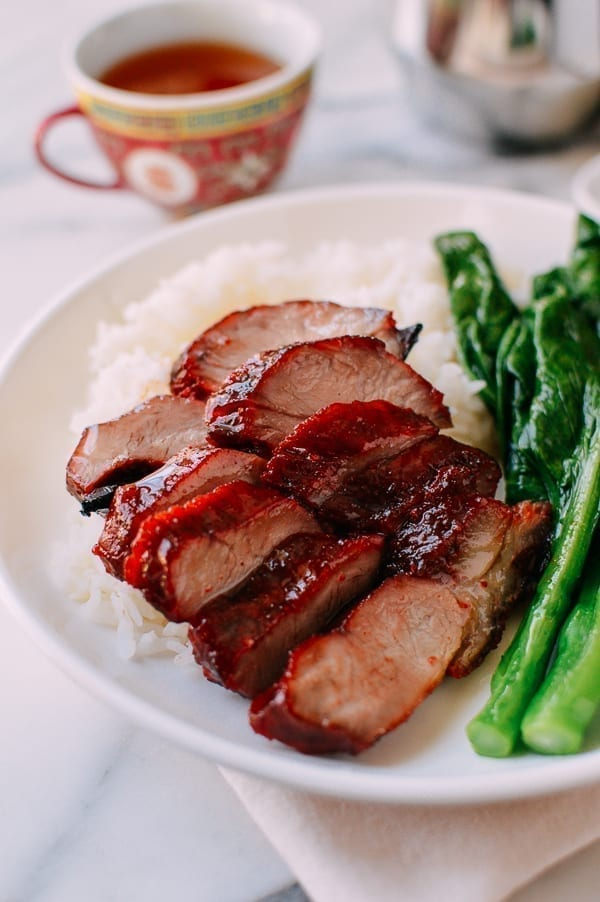
Photo: thewoksoflife.com 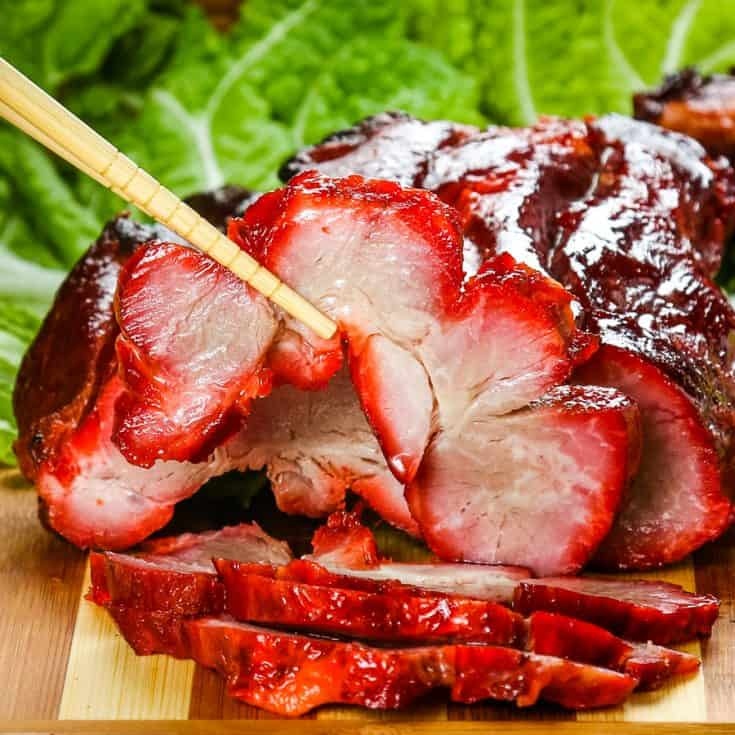
Photo: allwaysdelicious.com -
Kung Pao Chicken, unquestionably one of the top 10 Chinese meals, is a popular dish among people all over the world. Its unique flavor of sweet and sour with a hint of spice is popular all over the world, and for many foreigners, this dish has become synonymous with Chinese food. The chopped chicken is the key component in Kung Pao Chicken. Stir-frying the chicken with peanuts and dried chiles gives it a fresh, crunchy flavor that is spicy but not overpowering.
Ingredients
- Chicken:
- 28 ounces (800g) boneless/skinless chicken breast cut into 1 inch cubes
- 1 tablespoon shaoxing wine or dry sherry
- 1 tablespoon light soy sauce
- 2 teaspoons baking soda
- 1 teaspoon cornstarch / corn flour
- Sauce:
- 1/2 cup low-sodium chicken stock (or broth) -- water can be used
- 5 tablespoons light soy sauce
- 2 tablespoons Chinese black vinegar (or substitute good-quality balsamic vinegar)
- 2 tablespoon Chinese Shaoxing wine (or dry sherry)
- 2 teaspoon dark soy sauce
- 2 teaspoons hoisin sauce
- 2 tablespoons sugar*
- 1 teaspoon cornstarch / corn flour
- Stir Fry:
- 4 tablespoons cooking oil divided
- 1 1/2 tablespoons garlic (4-6 cloves)
- 1 tablespoon ginger
- 1/2 red bell pepper (capsicum) seeded and diced
- 1/2 green bell pepper (capsicum) seeded and diced
- 8-10 dried chilies cut into ½-inch pieces (adjust to taste)
- 1 tablespoon Sichuan peppercorns, lightly toasted and ground**
- 4 green onion / scallion stems cut into 1-inch pieces
- 1/2 cup roasted/unsalted peanuts
- 2 teaspoons sesame oil optional
Instructions
- In a small dish, combine all of the ingredients for the chicken; cover and marinate for 10 minutes (if time allows).
- Set aside after whisking together the sauce ingredients until the sugar has dissolved.
- Over high heat, heat a big skillet, pan, or wok. Allow 2 teaspoons of frying oil to heat up before adding the marinatedchicken. Fry the chicken for 3-4 minutes, tossing periodically, until the edges are golden brown. Remove the pan from the heat and set it aside.
- In the same pan/wok, add the remaining cooking oil. Stir in the garlic, ginger, chopped chili peppers (capsicums), and
- Sichuan peppercorns for 1 minute.
- Mix the prepared sauce, then pour it into the pan and bring to a boil, stirring constantly.
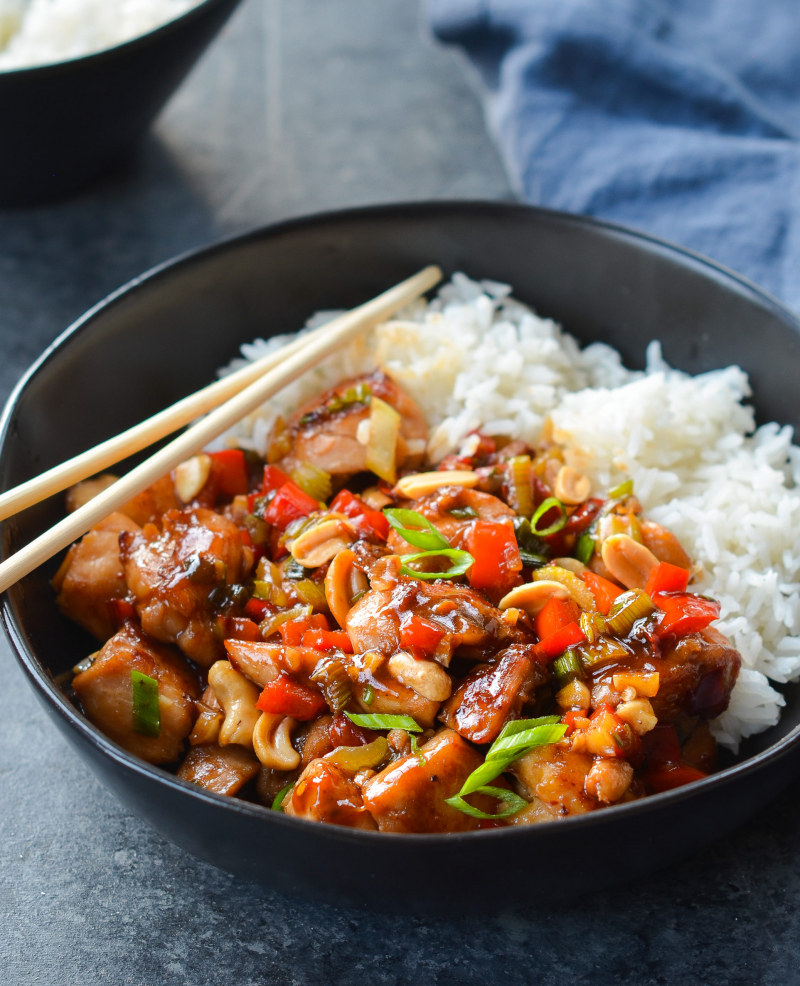
Photo: onceuponachef.com 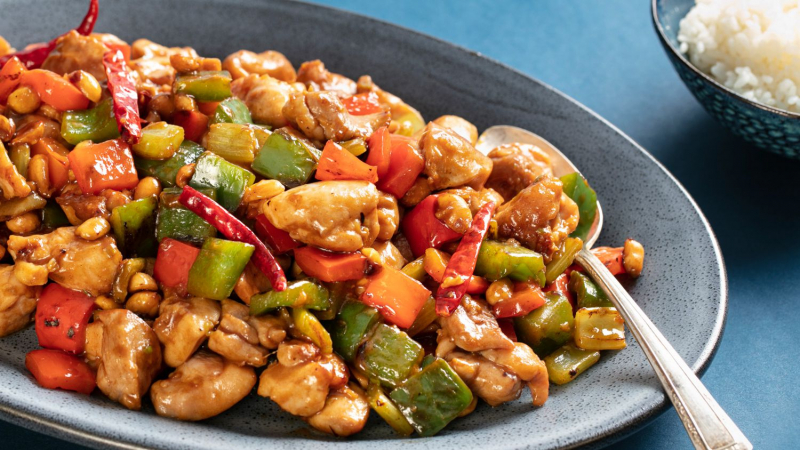
Photo: seriouseats.com -
Stir-fried noodles are known as Chow Mein in Cantonese. It's one of the greatest Chinese recipes, including noodles, onion, sliced beef, green pepper, and green onion as the main ingredients. To begin, boil the noodles until they are 90 percent done. After the noodles have cooled, stir-fry them with the remaining ingredients until golden yellow. Chow Mein is most Chinese people's first pick for late-night supper since it is simple to prepare.
Ingredients
- 225g dried or fresh egg noodles
- 1 tbsp sesame oil, plus 1 tsp
- 100g boneless, skinless chicken breasts, cut into fine shreds
- 2½ tbsp groundnut oil
- 2 garlic cloves, finely chopped
- 50g mangetout, finely shredded
- 50g prosciutto or cooked ham, finely shredded
- 2 tsp light soy sauce
- 2 tsp dark soy sauce
- 1 tbsp Shaohsing rice wine or dry sherry
- ½ tsp freshly ground white pepper
- ½ tsp golden caster sugar
- 2 spring onions, finely chopped
Instructions
- For the marinade, combine 100g chicken breasts, cut into tiny shreds, 2 tsp light soy sauce, 2 tsp Shaohsing rice wine or dry sherry, 1 tsp sesame oil, 12 tsp white pepper, and 12 tsp salt, mix well, and marinate for about 10 minutes.
- Preheat a wok to high heat. Add 1 tbsp groundnut oil and the chicken shreds when the oil is extremely hot and slightly smoking.
- Stir-fry for 2 minutes before transferring to a platter.
- Clean the wok and reheat it until it is extremely hot before adding 112 tablespoons peanut oil.
- Add the 2 finely chopped garlic cloves and stir-fry for 10 seconds, or until the oil is slightly smoking.
- Add the 2 finely chopped garlic cloves and stir-fry for 10 seconds, or until the oil is slightly smoking.
- Stir in 50g finely shredded mangetout and 50g finely shredded prosciutto for 1 minute.
- 2 teaspoons light soy sauce, 2 teaspoons dark soy sauce, 1 tablespoon Shaohsing rice wine or dry sherry, 12 teaspoons white pepper, 12 teaspoons golden caster sugar, 2 teaspoons salt
- 2 minutes of stir-frying Return the chicken to the noodle mixture, along with any liquids. Cook for 3-4 minutes, or until the chicken is done.
- Add 1 tsp sesame oil and a few last stirs to the mixture. Serve immediately on a warmed plate.
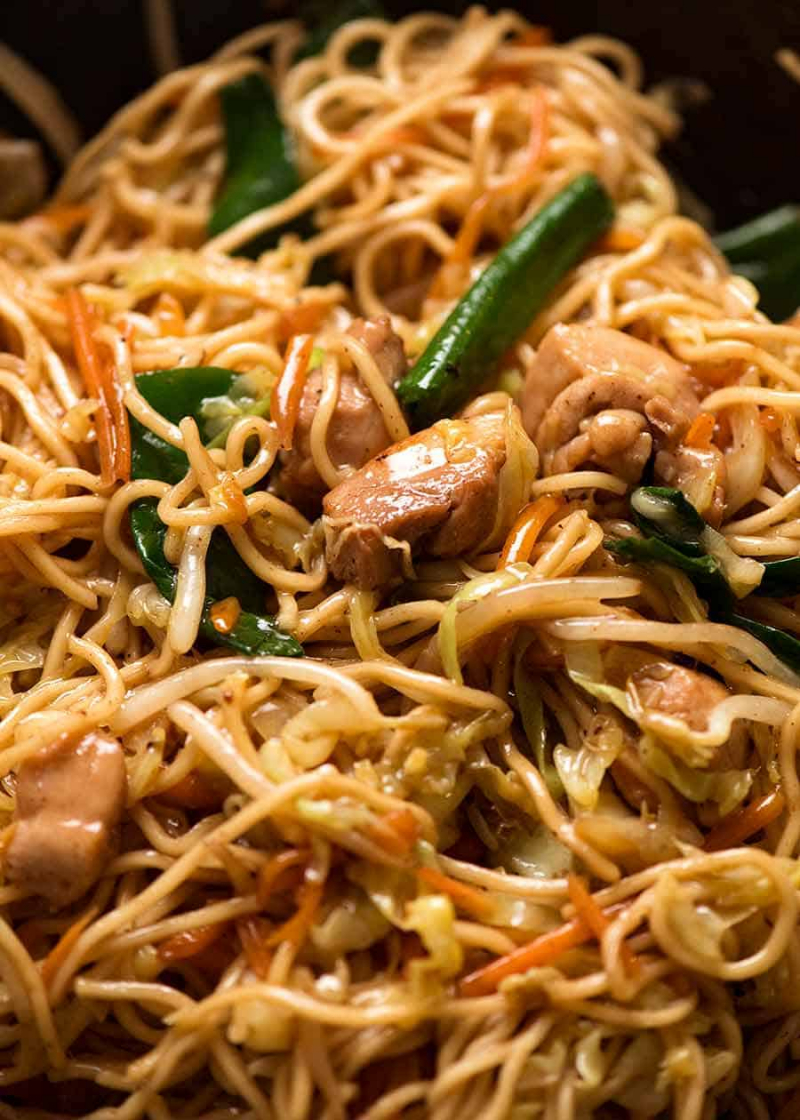
Photo: recipetineats.com 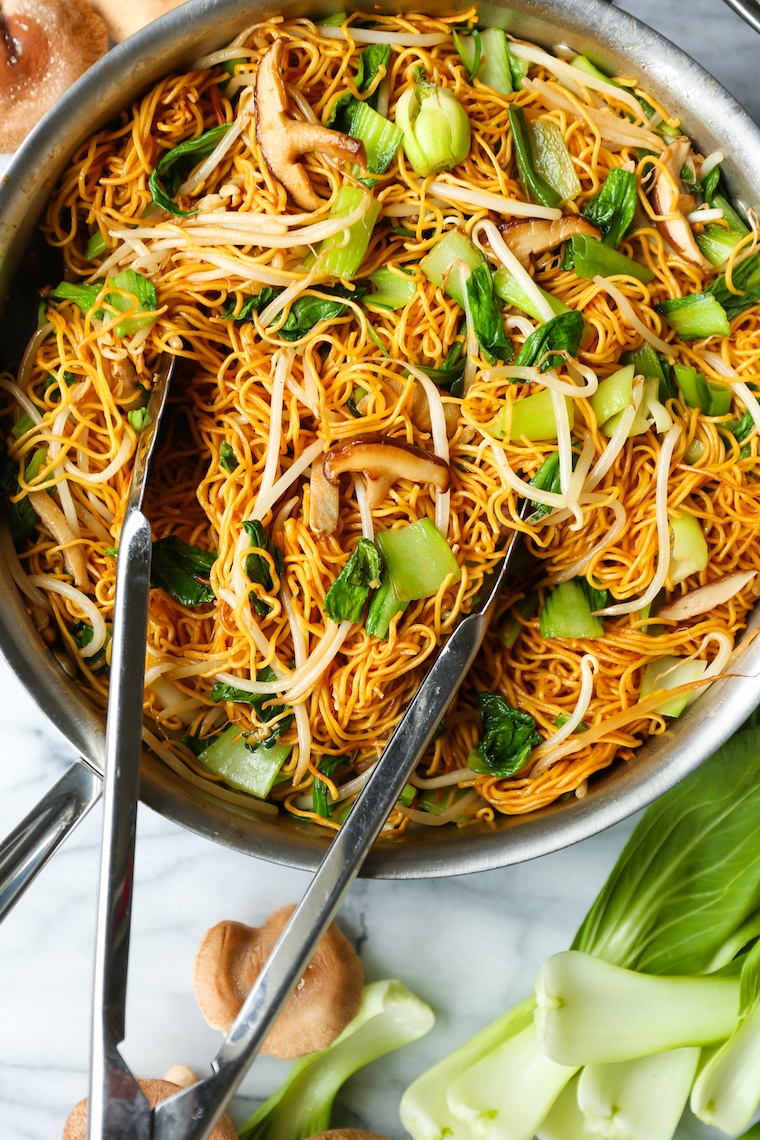
Photo: damndelicious.net -
Yangzhou Fried Rice is undoubtedly one of the most well-known Chinese dishes, with a wide following across the country. Yangzhou Fried Rice, as its name suggests, has its origins in Yangzhou, Jiangsu Province, and may be dated back to the Spring and Autumn Period (770 – 476 BC). The two most significant components are rice and eggs. Yangzhou Fried Rice, which is served with ham, shrimp, and peas, is not only fresh and aromatic, but also vividly colored to whet customers' appetites.
Ingredients
- Main Ingredients
- 2 cups Thai rice
- 1.5 cups water
- 2 oz carrot
- 2 oz peas
- 5 oz char siu (You can use ham or spam if you can't get char siu)
- 4 oz shrimp
- 2 egg
- 2 scallions
- Flavors
- 0.50 tsp salt
- 2 tbsp light soy sauce
- 2 tbsp oil
- Cooking Ingredients
- 2 cups water
- 1 tbsp oil
- 0.50 tsp salt
Instructions
- Soak the dried shrimp in hot water for 20 minutes if preferred, then drain and set aside in a small dish.
- If using the hot ketchup sauce: Combine the ketchup and chili sauce in a small bowl and put aside.
- For the fried rice: Heat a wok over high heat and add 1 tablespoon peanut oil. Add the eggs and scramble, then set aside on a plate.
- In the same wok, add the remaining 1 tablespoon of peanut oil. Stir in the ginger and cook for less than a minute. After that, add the carrots and stir-fry for another minute. Cook for 2 minutes after adding the pork, soaking dried shrimp, and mushrooms. After that, throw in the peas and cooked rice. Return the cooked egg to the wok. Combine the light soy sauce, salt, and pepper in a mixing bowl. Add the sesame oil and spicy ketchup sauce at the very end. Check the seasoning and season with salt and pepper to taste. Serve immediately with green onions as a garnish.
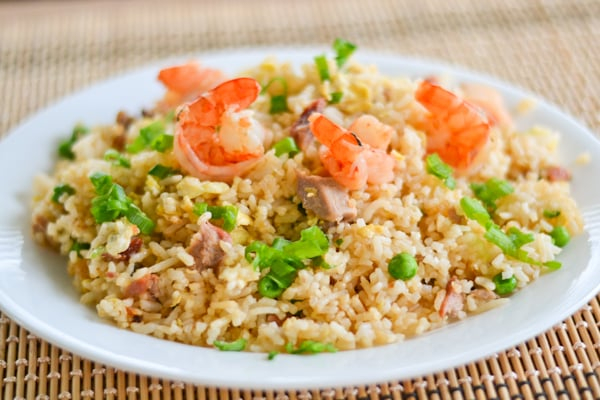
Photo: recipesxp.com 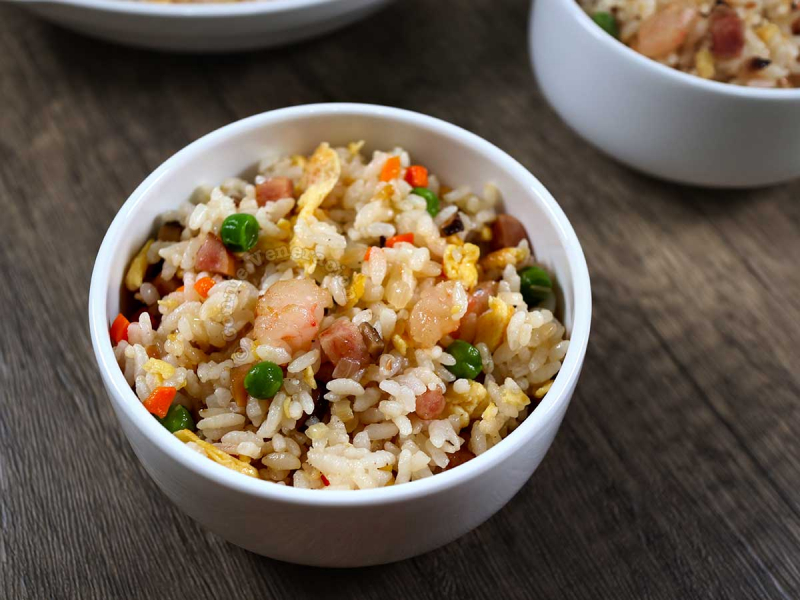
Photo: devour.asia -
Despite the presence of the term "fish" in the name, neither fish nor fish sauce are utilized in the preparation of this dish. Broad bean paste, salt, white sugar, cooking wine, soy sauce, and starch all contribute to the taste of the fish. People slice lean pork and stir-fry it with lettuce, dried agarics, garlic, and ginger in a sauce they've prepared. Fish-Flavored Shredded Pork is one of the most popular Chinese recipes to serve with rice because of its refreshing flavor of sweet and spicy.
Ingredients
- 250 g pork tenderloin
- 5 g dried black "wood ear" fungus
- 100 g bamboo shoots
- 1 medium sized carrot
- 3 cloves garlic
- 3 scallions
- 3 tbsp vegetable oil
- 1 thumb-sized piece of ginger
- 1 tbsp Chinese cooking sherry/wine
- 1 tbsp cornstarch
- 1/4 tsp salt
Instructions
- Soak the black fungus in a large bowl of warm water for 1 hour to rehydrate. Remove the hard stems, rince well, and drain. Cut into thin slices, set aside.
- Cut pork into 3 cm long, thin slices. Combine pork slices, Chinese cooking wine, salt and 1 tbsp cornstarch in a medium-sized bowl, mix well. Add 1 tbsp oil, toss well, set aside.
- Cut carrot and bamboo shoots into thin, almost shredded, slices about 3 cm long. Set aside. Mince garlic and ginger, set aside separate from vegetables.
- Mix sauce ingredients in a medium-sized bowl and set aside.
- Heat 1 tbsp oil in a wok on medium to high heat. Add marinaded pork mixture into the wok, frying 30 seconds, and then gently separate the pork slices with a spatula. Stir fry for about 1 minute more. Remove from wok.
- Add 1 tbsp oil into the same wok. When oil is hot, stir fry minced garlic and ginger for 10 seconds until fragrant. Add carrot and bamboo shoots, stir and cook for about 1 minute.
- Add pork and black fungus to the wok, mix well, then add sauce mixture, frying for 1 minute. Make sure all the ingredients are evenly coated with sauce.
- Place on a serving plate, and garnish with finely-chopped scallions. Serve immediately.
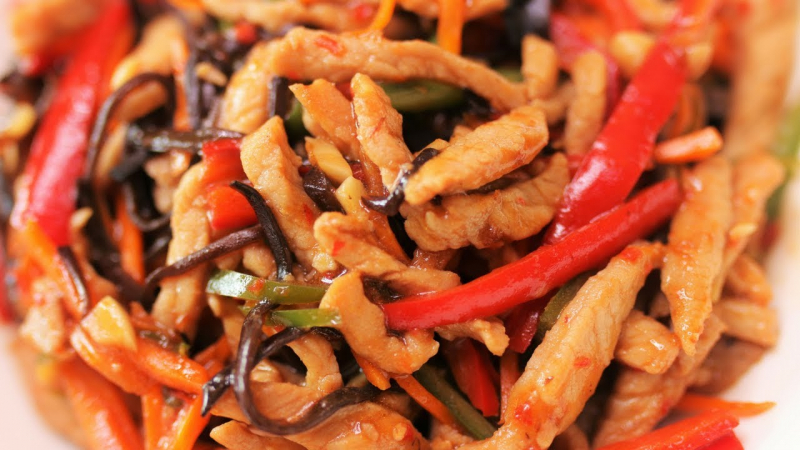
Photo: youtube.com 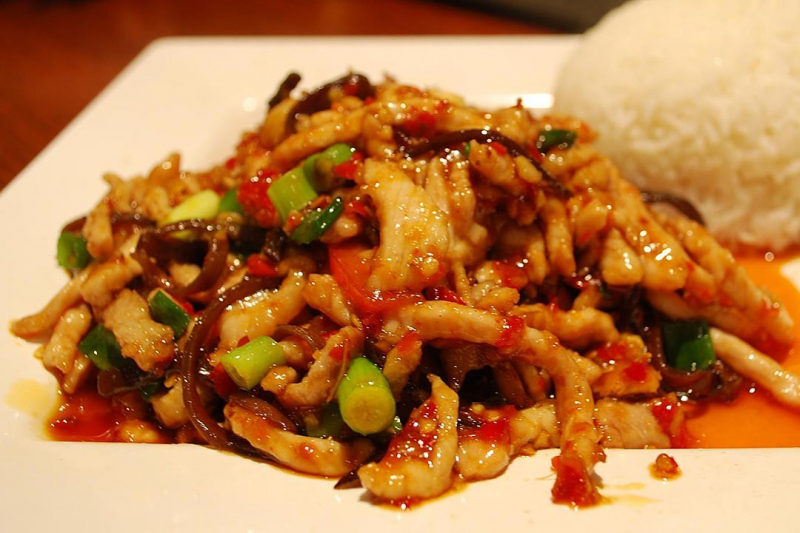
Photo: lostlaowai.com -
Another traditional Chinese meal is Sweet and Sour Pork Fillet, which is particularly popular among ladies and children. The pork is frequently coated in starch before being cooked in a pot of boiling ketchup. As a result, the Sweet and Sour Fillet has a sweet and sour flavor, and the juicy pork coated in crispy crust gives you a unique tongue sensation.
Ingredients
- 1 (1 1/4 pound) pork tenderloin, trimmed of silver skin
- salt and ground black pepper
- ⅓ cup ketchup
- ⅓ cup seasoned rice vinegar
- 1 (8 ounce) can pineapple chunks, drained with juice reserved
- 2 tablespoons brown sugar
- 4 cloves garlic, minced
- 2 teaspoons hot chili sauce
- 1 teaspoon soy sauce
- 1 pinch red pepper flakes
- 1 tablespoon vegetable oil
- 1 teaspoon butter
- ¼ cup chopped green onion (white part only)
- 2 tablespoons chopped green onion tops
Instructions
- Tenderloin should be cut into four pieces. Place between two pieces of plastic wrap in a single layer and pound with a meat mallet until each is approximately 1-inch thick. Season with salt and black pepper to taste.
- In a mixing bowl, combine ketchup, rice vinegar, pineapple juice, brown sugar, garlic, hot chili sauce, soy sauce, and red pepper flakes. Remove from the equation.
- In a skillet, heat the vegetable oil over high heat. Reduce heat to medium-low and add the meat to the pan. Cook for 5 to 6 minutes per side, or until both sides are browned and cooked through. Place on a platter to cool.
- Return the skillet to a medium heat setting. In a heated pan, melt the butter. Stir in pineapple pieces after the butter has melted and begun to brown. 3 to 4 minutes, stirring occasionally, until pineapple is golden brown.
- 1/4 cup green onion and the ketchup combination (white parts). Reduce heat to low and cook for 5 minutes, or until garlic and onion have softened.
- Return the meat to the skillet and cook, turning constantly, until cooked through. 2 tablespoons green onion tops for garnish
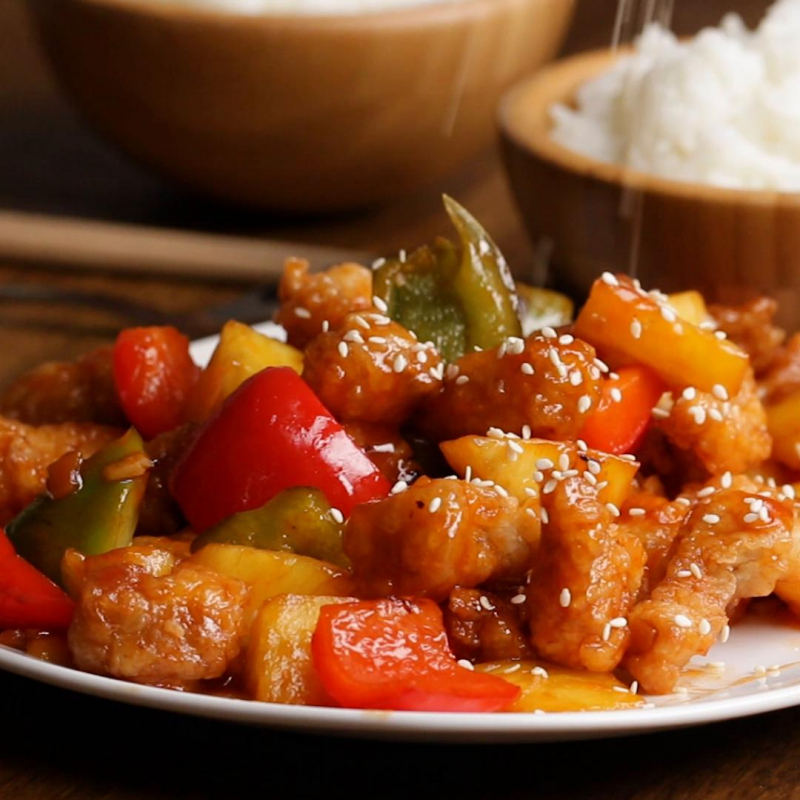
Photo: tasty.co 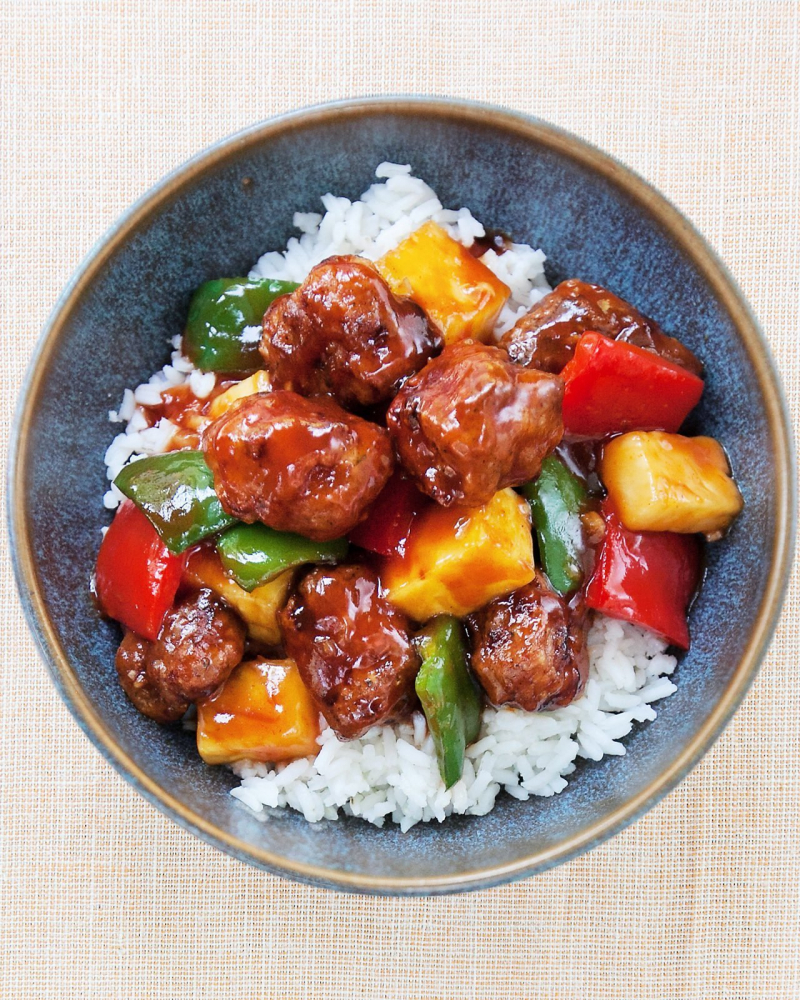
Photo: bluejeanchef.com -
Ma Po Tofu is a popular Chinese dish from Sichuan cuisine, and its hot and spicy flavor best exemplifies the characteristics of this category. This course is supposed to have been invented in 1862 by a woman named Chen Mapo, hence the name. In the final stage, sprinkle red and hot broth, ground beef, and sliced green onion over the delicate tofu to enhance the flavor.
Ingredients
- ½ cup oil(divided)
- 1-2 fresh Thai bird chili peppers (thinly sliced)
- 6-8 dried red chilies (roughly chopped)
- 1 – 1 1/2 tablespoons Sichuan peppercorns (powdered or finely ground, reserving 1/4 teaspoon for garnish at the end; if you are sensitive to spice, adjust to taste, using less than 1 tablespoon if needed)
- 3 tablespoons ginger (finely minced)
- 3 tablespoons garlic (finely minced)
- 8 ounces ground pork (225g)
- 1-2 tablespoons spicy bean sauce (depending on your desired salt/spice levels)
- 2/3 cup low sodium chicken broth (or water)
- 1 pound silken tofu (450g, cut into 1 inch cubes)
- 1 1/2 teaspoons cornstarch
- 1/4 teaspoon sesame oil (optional)
- 1/4 teaspoon sugar (optional)
- 1 scallion (finely chopped)
Instructions
- To begin, we toast the chilies. You can skip this step if you have homemade roasted chili oil. Warm-up your wok or a small saucepan on low heat. 14 cup oil should be added, along with the fresh and dried peppers. Stir occasionally and cook until the peppers are fragrant, about 5 minutes, being careful not to burn them. Take the pan off the heat and set it aside.
- In your wok, heat the remaining 14 cups of oil over medium heat. Stir in the ground Sichuan peppercorns every 30 seconds for 30 seconds. Stir in the ginger. Add the garlic after 1 minute. Fry for 1 minute more, then increase the heat to high and add the ground pork. Break up the meat and fry it until it's done.
- Stir in the spicy bean sauce until well combined. Stir in 23 cups of chicken broth to the wok. Allow this to simmer for about a minute. While that is happening, prepare your tofu and combine 14 cups of water and cornstarch in a small bowl and mix thoroughly.
- Stir in the cornstarch mixture to your sauce. Allow it to bubble until the sauce thickens. (If it becomes too thick, add a splash of more water or chicken stock.)
- Then add your previously prepared chili oil, peppers, and all! If you're making your own chili oil, only use the standing oil because it's likely that you've salted it and you want the oil, not the salt. Stir in the tofu and the oil to the sauce.
- Toss the tofu in the sauce gently with a spatula. Allow for 3-5 minutes for everything to cook. Stir in the sesame oil, sugar (if used), and scallions until the scallions are just wilted.
- If desired, garnish with a final sprinkle of Sichuan peppercorn powder.
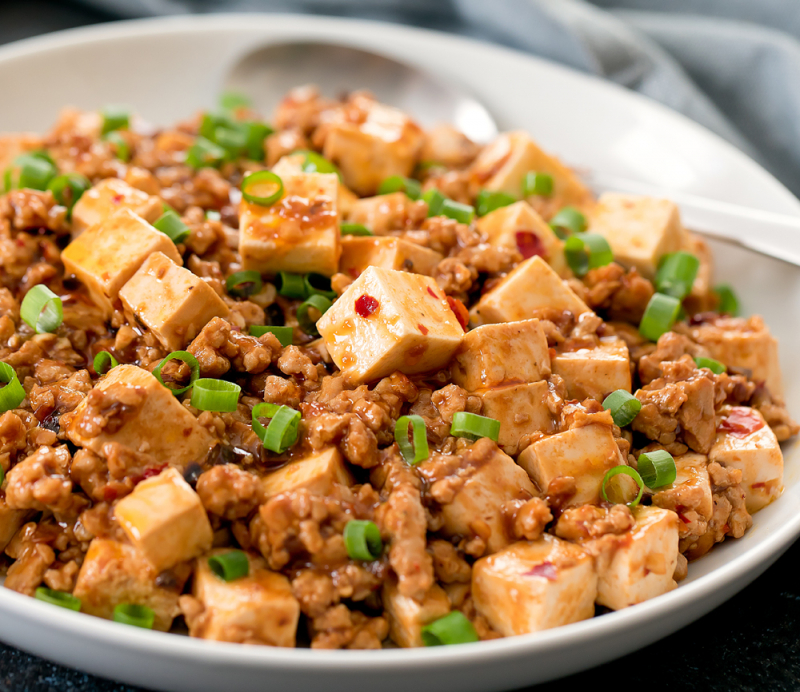
Photo: kirbiecravings.com 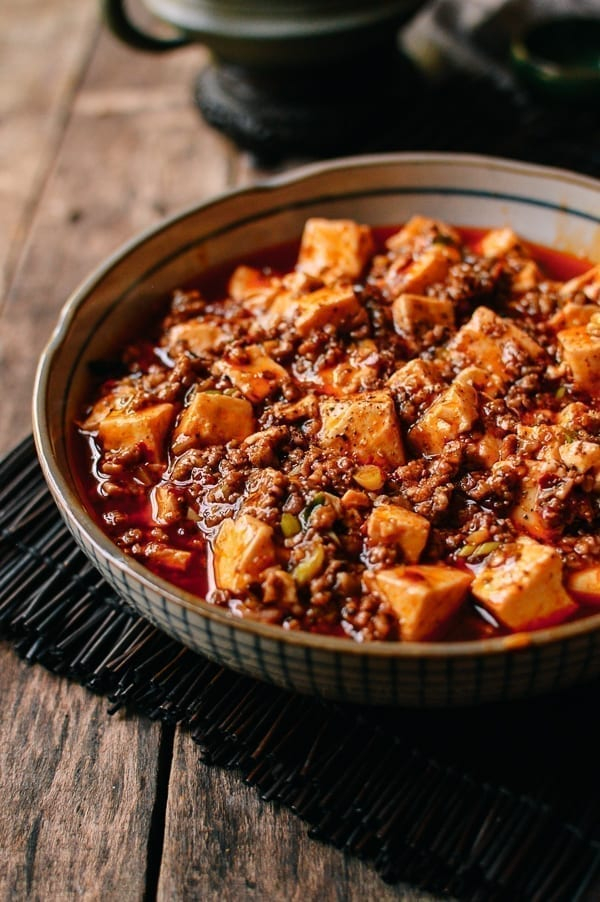
Photo: thewoksoflife.com -
Spring rolls are a type of filled, rolled appetizer or dim sum popular in East Asian and Southeast Asian cuisines. Depending on the culture of the region, the type of wrapper, fillings, and cooking technique employed, as well as the name, vary significantly across this broad area.
Ingredients
- TO ASSEMBLE THE FILLING:
- 2 tablespoons oil
- 1 clove garlic (minced)
- 10 dried shiitake mushrooms (soaked until softened and thinly sliced)
- 2 medium carrots (julienned, about 1 cup)
- 1 cup bamboo shoots (julienned; fresh is preferred, but canned is fine too)
- 1 small napa cabbage (julienned, about 6 cups)
- 1 tablespoon Shaoxing wine
- 2 tablespoons light soy sauce
- 1 teaspoon sesame oil
- ½ teaspoon salt (or to taste)
- white pepper (to taste)
- 1/4 teaspoon sugar
- 2 tablespoons cornstarch (dissolved in 2 tablespoons cold water)
- FOR WRAPPING:
- 1 package spring roll wrappers (8" squares; this recipe makes about 20 spring rolls)
- 1 tablespoon cornstarch (dissolved in 1 tablespoon boiling water for sealing the spring rolls)
- Canola oil (or peanut or vegetable oil, for frying)
- FOR THE DIPPING SAUCE:
- 2 teaspoons sugar
- 2 teaspoons hot water
- 1 teaspoon Worcestershire sauce
- 1 tablespoon soy sauce
Instructions
- Set aside for 30 minutes after mixing the pork with the marinade ingredients. Meanwhile, prepare the remaining ingredients. All of the vegetables should be roughly the same size. You want everything to be the same size so that everything blends together.
- Brown the pork in 2 tablespoons oil over high heat, then add the garlic, mushrooms, and carrots. After 30 seconds, add the bamboo shoots, napa cabbage, and Shaoxing wine and stir fry for another 30 seconds. Stir-fry for another minute. As the napa cabbage releases a lot of moisture, reduce the heat to simmer the mixture.
- Combine the soy sauce, sesame oil, salt, white pepper, and sugar in a mixing bowl. At this point, you can add 1/4 cup of the decanted water from soaking the dried mushrooms. It enhances the mushroom flavor, so this is entirely up to personal preference. You may also need to simmer the filling for a longer period of time to reduce the extra liquid.
- Continue to simmer the filling for 3 minutes, or until the napa cabbage is completely wilted, and then stir in the corn starch slurry to thicken. The amount of slurry you add depends on the wetness of the filling (this varies depending on whether your cabbage was moist or if you added the optional mushroom water), but there should be no standing liquid at all.
- Allow the filling to cool in a large shallow bowl. Place in the refrigerator for at least one hour to cool. To make wrapping easier, start with a cold filling. The key to wrapping spring rolls is to keep them tight but not overstuffed. If possible, use fresh spring roll wrappers, as freezing the wrappers can cause the spring roll skin to become too moist.
- Place the wrapper on a flat surface with a corner facing you. Use about two spoonfuls of the mixture per spring roll, about 2 inches from the corner closest to you. Roll it once and fold over both sides like you're making a burrito. Roll it into a cigar shape as you go. Brush a bit of the cornstarch water onto the corner of the wrapper that is farthest away from you with your fingers to seal it.
- In case you're wondering, we tried egg wash instead of the cornstarch mixture to seal the spring roll, but the egg wash "stains" the spring roll, so the cornstarch mixture is preferable.
- Place one roll on each tray. This recipe yields approximately 18-20 spring rolls. You can also freeze these spring rolls on the tray overnight and then transfer them to a zip-lock bag when completely frozen for later use. We usually fry some fresh and freeze the rest, unless we're throwing a party, in which case these disappear like hotcakes!
- Fill a small pot (which requires less oil) with oil until it's 2 to 3 inches deep to fry the spring rolls. Slowly heat the oil over medium heat until it reaches 325 degrees. Add the spring rolls one at a time, gently frying in small batches. Roll them carefully in the oil to ensure even cooking until golden brown, then transfer to a plate lined with paper towels.
- To make the dipping sauce, combine all of the ingredients in a small sauce pan. Heat until just simmering, then pour into a small bowl. Serve the spring rolls hot, accompanied by the dipping sauce!
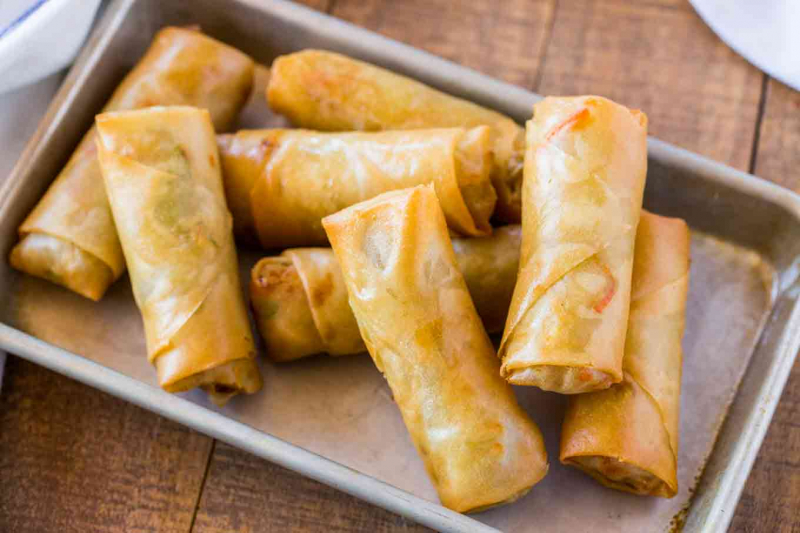
Photo: dinnerthendessert.com 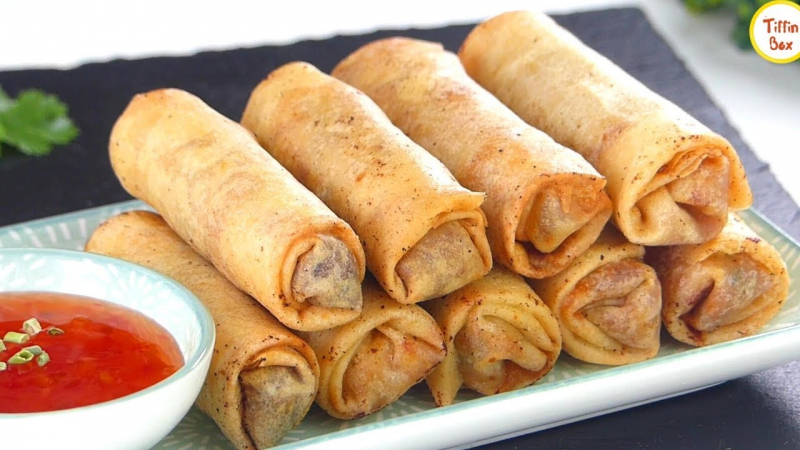
Photo: youtube.com












